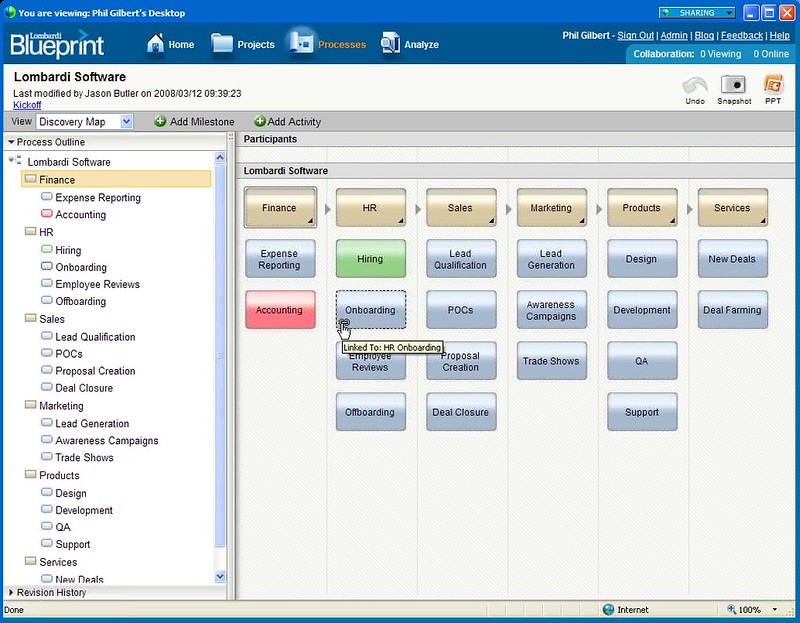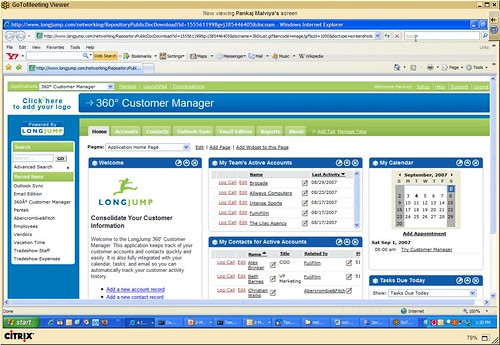I’m at the IT360 for a couple of hours this morning, mostly to hear Matthew Glotzbach, director of product management for Google Enterprise. It’s a sad commentary on the culture of Canadian IT conferences shows that this session is entitled "Meet Matthew Glotzbach of Google" in the conference guide, as if he doesn’t need to actually talk about anything, just show up here in the frozen north — we need to work on that "we’re not worthy" attitude. 🙂
Google’s Enterprise division includes, as you might expect, search applications such as site search and dedicated search appliances, but also includes Google Apps which many of us now use for hosting email, calendaring and document collaboration functions.
Glotzbach’s actual presentation title is "Head in the Clouds", referring to cloud computing, or more properly in this context, software as a service. He made an analogy between SaaS applications and electricity, referencing Nicholas Carr’s book The Big Switch, talking about the shift from each factory generating its own power to the centralized generation of electricity that is now sold as a service on the power grid. Just as it took a cultural shift to move from each company having their own power generation facilities (and a VP of electricity who was intent on defending his turf), we’re now undergoing a cultural shift to move from each company managing all of their own IT services to using best-of-breed services at a much lower cost over the internet.
He discussed five things that cloud computing has given us:
- Democratization of information, giving anyone the chance to have their say in some way, from Wikipedia to Twitter to blogs. This is dependent upon and facilitated by standards, particularly simple, easy-to-use standards like RSS; in fact, all public APIs for Google Apps are RSS-based. What IT can learn from this is to keep things simple, something that enterprise IT is not really known for. Cloud computing also allows for a much freer exchange of information between people who don’t speak the same language, through real-time translation capabilities that aren’t feasible on a desktop platform: for example, add en2zh ([email protected]) to your Google group chat so that you can have a text chat with someone with one of you typing in English and the other in Mandarin Chinese.
- Economics of the new information supply chain. Cloud computing fundamentally changes the economics of enterprise IT: the massive scale of cloud-based storage (e.g., Google Apps, Amazon S3) and computing (e.g., Amazon EC2) drives down the cost so much that it’s almost ridiculous not to consider using some of that capacity for enterprise functionality. Of course, we’ve been seeing this manifested in consumer applications for a couple of years now, with practically unlimited storage offered in online email and photo storage applications, but more companies need to start making this part of their enterprise strategy to reduce costs on systems that are essential but not a competitive differentiator.
- Democratization of capabilities, allowing a developing nation to compete with a developed country, or a small business to compete with a major corporation, since they all have access to the same type of IT-related functionality through the cloud. In fact, those without legacy infrastructure are sometimes in a better position since they can start with a clean slate of new technology and become innovative collaborators. It’s also possible for any company, no matter how small, to get the necessary Googlejuice for a high ranking in search results if they have quality, targeted information on their site — as the cartoon says, on the internet no one knows you’re a dog.
- Consumer-driven innovation will set the pace, and will drive IT. The consumer market is much more Darwinian in nature: consumers have more choices, and are notoriously fast to switch to another vendor. Businesses tend not to do this because of the high costs involved in both the selection process and in switching between vendors; I’m not sure that Glotzbach is giving enough weight to the costs of switching corporate applications, since he seems to indicate that companies may adopt more of a consumer-like fickleness in their vendor relationships. As more companies adopted more cloud computing, that will likely change as it becomes easier to switch providers.
- Barriers to adoption of cloud computing are falling away. The main challenges have been connectivity, security, offline access, reliability and user experience; all of these have either been fully addressed or are in the process of being addressed. My biggest issue is still connectivity/offline access (which are really two sides of the same coin) such that I use a lot of desktop applications so that I can work on planes, in hotels with flaky access, or at the Toronto convention centre that I’m at today. He had some interesting stats on security: 60% of corporate data resides on desktop and laptop computers, and 1 in 10 laptops are stolen within 12 months of purchase — the FBI lost 160 laptops in the last 44 months — such that corporate security professionals consider laptops to be one of the biggest security risks. In other words, the data is probably safer in the cloud than it is on corporate laptops.
He finished up with a slide showing a list of well-known companies, all of which use Google Apps; alarmingly, I heard someone behind me say "just show me one Canadian company doing that". I’m not sure if that is an indication of the old-school nature of this conference’s attendees, or of Canadian IT businesspeople in general.
Glotzbach’s closing thoughts:
- On-premise software is not going away
- Most of the interesting innovation in software and technology over the next decade will be "in the cloud"
- Market will have lots of competitors
- Your new employees are the cloud generation, both welcoming and expecting that some big part of their social graph lives in the cloud
- We (Google and other cloud providers) need to earn your trust.
Great presentation, and well worth braving the pouring rain to come out this morning.



